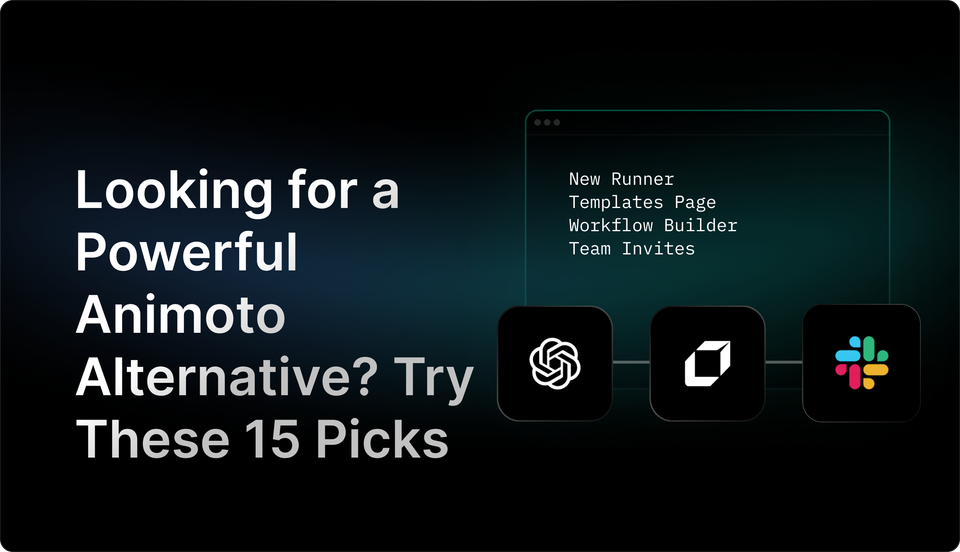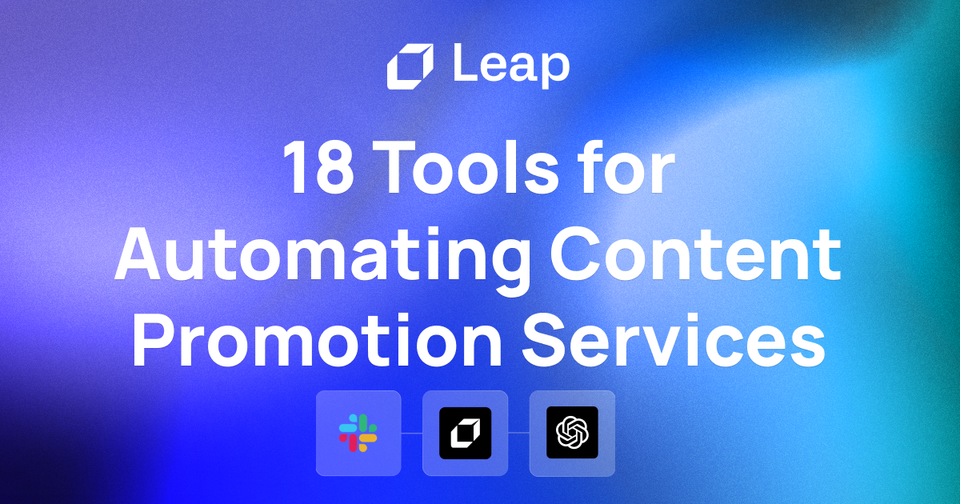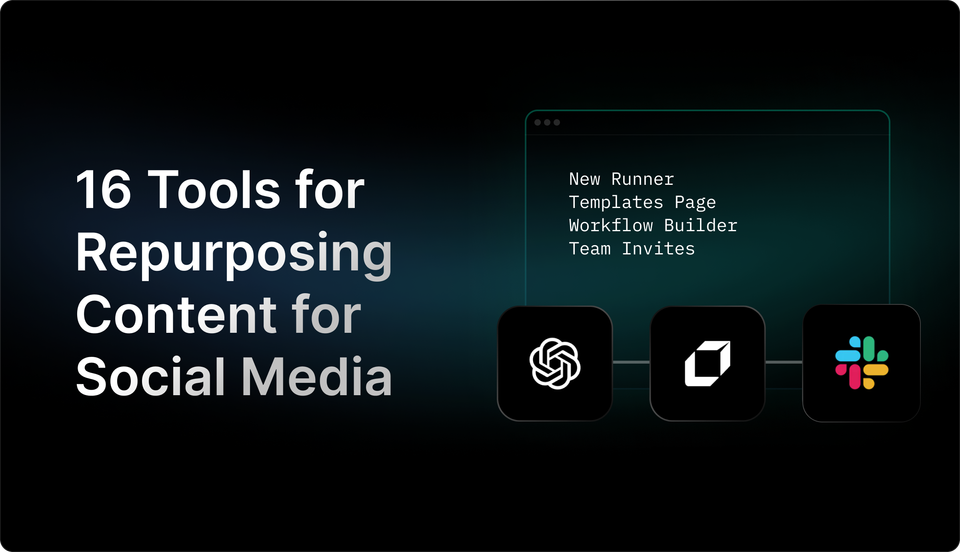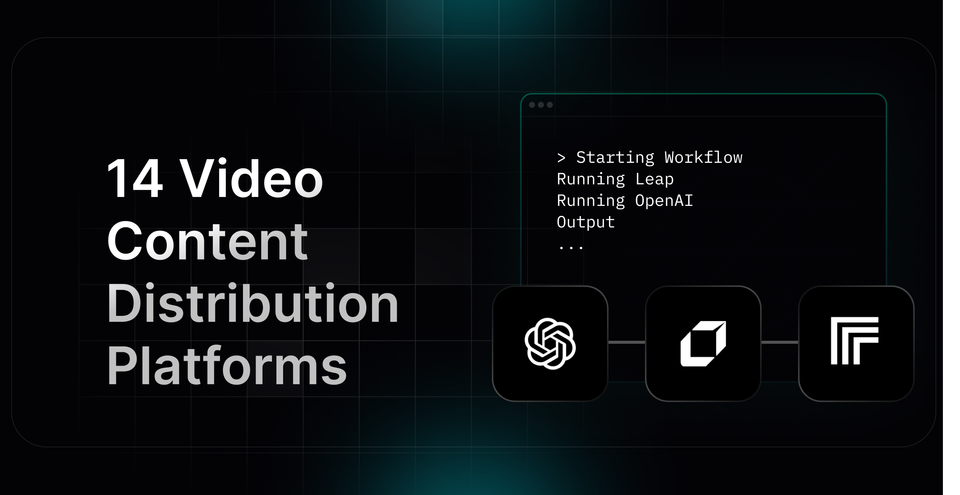5-Step Guide to a Content Repurposing Workflow That Works
Transform your content strategy to creating a successful content repurposing workflow that will maximize your reach and engagement.

Are you looking for ways to maximize your content's visibility and engagement? Understanding the benefits of a content repurposing workflow is crucial. By improving your content distribution, you can increase traffic to your website and amplify your brand message. Repurposing content can also help you save time and effort by repackaging your existing content into different formats. It allows you to reach a broader audience and grow your online community. This blog post will explore the steps you need to follow to build a successful content repurposing workflow.

What is a Content Repurposing Workflow and Why its Important?

At its heart, content repurposing workflow can be viewed as a strategic blueprint for maximizing your existing material’s core value. It’s a systematic way to transform previously created marketing content – blog articles, infographics, podcasts, etc. – into new formats for different platforms and audiences. It essentially promotes extracting as much potential as possible from your previous content marketing efforts.
Why is it Important?
The reality is that content repurposing is an ongoing cycle of optimization and growth, not a one-time fix. By adopting a systematic strategy, you can maximize your content’s marketing potential, amp up your brand voice, and create a powerful impact – here’s how:
- Repurposed material expands your audience and increases your content investment returns by reaching new people on other platforms.
- Using your existing content as a starting ground, you can avoid starting from scratch and free up resources for more critical projects.
- Having up-to-date, helpful content on several platforms boosts your search engine optimization and increases your brand visibility in search results.
- Repurposing allows you to use numerous formats to explore topics in greater detail, create stories, and strengthen your relationships with audiences.
- You can create well-informed future content creation strategies by monitoring performance across channels to discover what resonates with diverse audiences.

Related Reading
- Content Promotion
- Content Repurposing
- Content Distribution Strategy
- Content Promotion Strategies
- How To Repurpose Content
- Content Distribution Platforms
How Do You Identify the Best Content to Repurpose?

Choosing content that has performed well, is evergreen, or can be updated to reflect current trends is crucial when considering what to repurpose. The content that has proven to work for your business should be your priority when deciding what to repurpose. It must include the evergreen pieces you have created in the past. Since evergreen content doesn’t get old fast, you get a long time to repackage it for different formats and platforms. Here’s how to identify the best topics to repurpose for your brand
Identify your pillar content
Browse through all the content pieces you have created so far and select the best ones in terms of quality and long-term relevance. These pieces should be interesting and valuable enough for your audience to consume on various online platforms. Before publishing, make sure to run the selected content pieces through a reliable grammar checker to ensure they are polished and error-free for maximum impact across diverse online platforms.
Check Google Analytics
Use Google Analytics to see which pages are driving the most traffic. You can do this by accessing the “landing pages” report. Go to Behavior > Site Content > Landing Pages.
Find content that’s shared the most
Type in your website domain in a tool like Buzzsumo to check which of your pages have the most social media shares. Repurpose content that performs well in different formats. For example, turn long-form videos into audio podcast episodes. You can further slice them into bite-sized social media posts.
Revolutionizing Workflows with AI Automation
Leap helps you to automate your work with the power of AI. Partnered with Zapier, Vercel, and more, Leap enables you to supercharge your work by allowing you to create custom AI automations. Create sophisticated AI automations with no-code. Connect the tools you love with best-in-class AI text, image, and audio models.
Supercharge your existing tools with seamless AI integrations to OpenAI, Microsoft, and more. From summarizing documents, to voice translation, to AI call transcription, to AI avatar and asset generation, to SEO automation, to even automating the cold email creation and sending process, automate anything with Leap Workflows. The opportunities for automation are endless with Leap workflows.
Try Leap’s AI Workflows tool for free today.
How to Build an Effective Content Repurposing Workflow in 5 Steps

1. Define Your Repurposing Goals
Before beginning the content repurposing workflow, it is essential to establish clear goals. These goals should be specific, measurable, achievable, relevant, and time-bound (SMART). By setting up goals, you know precisely why you are repurposing content and can evaluate success based on the objectives.
Goals can include distributing thought leadership content through internal teams on social media or transforming video content into search-friendly blog posts. Understanding the purpose of your repurposing strategy will ensure you create a clear and effective workflow and can measure outcomes accurately.
2. Choose Anchor Formats for Repurposing
Anchor formats are the primary source of repurposed content. Selecting the right anchor formats can help you repurpose content effectively. Video-focused formats are excellent as video content typically has a broader reach and can be repurposed across various platforms efficiently. When choosing anchor formats, consider both long-form to short-form and short-form to long-form content. Evaluate the effort required to produce content for each format and its potential impact.
3. Create a Visual Workflow Chart
Mapping out your repurposing workflow visually can help organize the process and highlight the interconnectedness of each step. Include the original content publication channels, where the content will be repurposed, and the frequency of repurposing in your visual map. While the map provides a guideline, it is flexible and can change as needed. The visual representation helps plan, set goals, and adjust the strategy as required.
4. Choose Repurposing Approach
Decide how you will repurpose content based on the type of content and its intended channels. You can choose a one-to-one approach where content is repackaged for another medium without changing the actual content.
The one-to-many approach involves breaking down content into smaller, easily digestible pieces for different platforms. Content atomization involves creating new assets inspired by existing content. Ensure the repurposed content aligns with the goals and theme of the destination platform.
5. Optimize Your Workflow Speed
Speeding up the content repurposing workflow is essential to ensure efficiency. Use AI-powered tools to automate repetitive tasks and expedite the initial phase of content repurposing. Tools like ChatGPT can help format transcripts quickly, while Repurpose Studio can assist in finding and editing engaging clips. Automating tasks like resizing content for different platforms can save time and effort, allowing for a more streamlined repurposing workflow.
8 Must-Know Content Formats and Channels for Repurposing

1. Repurposing Content Through Email Marketing
Email marketing has always been the cat’s meow in driving traffic and engagement as long as you don’t treat your email list like a dumping ground. Treat it as an opportunity to build intimacy and show your brand personality. Share your best content with your email list. You can use it to announce upcoming events, build partnerships, tease snippets of your content, or even send your entire content to your subscribers. Email series, newsletters, and outbound cold emails are some of my favorite ways to recycle content using email.
Engage and Nurture with Drip Email Sequences
The idea of the email series is to break your content down into a series of emails sent one by one over time. You can use marketing automation to automate the entire process. Drip-feeding an email sequence is a great way to keep your audience engaged and stay top of mind. It also serves as a lead magnet to grow your list.
Building Connections through Story-based Newsletters
Story-based email newsletters are a creative way to recycle content without being overly promotional. The idea is to use stories from your everyday life to segue into the content you’re promoting. Stories add a personal touch and help you build rapport with your audience. As for outbound emails, let people know if you’ve mentioned them in your blog content. This is a great way to get more eyeballs on your content.
2. Repurposing Content Through Social Media
There are many social media platforms you can use to repurpose your content. Some of the most popular ones are Facebook, Twitter, LinkedIn, Pinterest, Instagram, and TikTok.
3. For Facebook, you can post a summary of your content and include a link to the full article
Most social platforms try to keep people on their site as much as possible, so split test sharing links vs. uploading native content to see which performs better.
4. Twitter is great for posting short snippets of your content along with a link to the full article
You can also use Twitter’s poll feature to ask followers what they think about your content. Twitter threads are also a great way to repurpose long-form content into bite-sized pieces.
5. LinkedIn is perfect for sharing interesting findings from your research or data from your case studies
Start conversations with your connections about the topics you’re sharing to get more engagement.
6. Instagram and Pinterest are great for sharing visual content
You can also use Instagram’s Stories feature to create short videos about your content. Use Pinterest’s Board feature to create boards around the topics you’re sharing.
7. TikTok is great, especially if you’re targeting younger audiences
The organic reach on TikTok is huge, so it’s a great way to get your content in front of new people.
8. Your social media post doesn’t have to be a direct promotion of your content
You can also post interesting behind-the-scenes photos or blooper videos to give your followers a peek at your content creation process.
Related Reading
- Repurposing Content For Social Media
- Content Promotion Services
- Video Content Distribution
- Animoto Alternative
- Social Media Distribution
- Content Repurposing Service
- Repurpose Video Content
- Paid Content Distribution
- Content Distribution Software
21 Helpful Tools to Enhance Your Content Repurposing Workflow

1. Leap AI
Leap helps you to automate your work with the power of AI. Partnered with Zapier, Vercel, and more, Leap enables you to supercharge your work by allowing you to create custom AI automations. Create sophisticated AI automations with no-code. Connect the tools you love with best-in-class AI text, image, and audio models.
Supercharge your existing tools with seamless AI integrations to OpenAI, Microsoft, and more. From summarizing documents, to voice translation, to AI call transcription, to AI avatar and asset generation, to SEO automation, to even automating the cold email creation and sending process, automate anything with Leap Workflows. The opportunities for automation are endless with Leap workflows.
Try Leap’s AI Workflows tool for free today.
2. Airtable
The tool is flexible enough to handle the entire content reuse process. Use it to manage lists of keywords to help you optimize content for search engines, build a content calendar to keep track of deadlines and assignments, and measure the metrics and audience feedback for your repurposed posts.
3. BuzzSumo
BuzzSumo helps you discover and filter results by content type (infographics, giveaways, interviews, videos, and guest posts) to see what’s already published about a given topic as you plan your content update. When you want to add new points of view to an existing article, BuzzSumo can help you find influencers and experts on your topic.
4. Google Tools (free and paid versions)
Google Analytics shows you how users interact with your content, including total page views over time, overall social engagement, and time spent on the site. Use these parameters to help you decide which content is best suited for repurposing.Google Search Console helps you see which pages attract the most links. Keep in mind that some content might attract links even if it doesn’t generate much traffic.
5. HockeyStack
HockeyStack is an analytics solution that helps you understand which content brings the most signups or other goals. For example, this tool will help you find out how much revenue or how many conversions each blog post brings in so you can focus your content reuse and repurposing around those topics.
The tool’s funnel analysis gives you a step-by-step journey of every visitor. You can quickly see which content converts, engages visitors, and even measure the quality of inbound leads. You can use that insight to guide your repurposing choices.
6. SE Ranking
Another way to decide which content makes sense to repurpose is to look at your search rankings and the search terms that drive the most traffic to your site. You can use SE Ranking (full disclosure, I work for the company) to track your ranking history, identify your most popular search terms, and discover which content achieved your goals in a certain period.
You can also use it to monitor the performance of your posts and those of your competitors on major social networks. The tool also helps you control the content and stay informed about significant changes to blog posts or web pages that you may not even know. These insights allow you to fine-tune your content reuse plans
7. Airstory
Writing platform Airstory lets you keep drafts, notes, and related content together as you work on a repurposing project. Use this drag-and-drop document builder to gather pieces of content you want to repurpose and collaborate with other content creators working on the same asset. The flexible tool lets you set up projects with deadlines, establish word-count goals, and upload templates for visuals, scripts, etc.
8. MeetEdgar
To schedule, manage, and republish your social media content, try MeetEdgar. This social media scheduling tool lets you create a “library” of social media posts that automatically reposts for you over time. You fill the library with text, images, links, and graphics, group them by category, and indicate the platforms on which you want to share them. MeetEdgar publishes the scheduled posts in each category; when the content runs out, the tool starts reposting it automatically.
9. Planable
Planable is another option that helps you streamline social media content publishing processes, from planning and creating new content to updating and republishing posts. The tool’s low learning curve lets you build and manage an efficient social media approval process. The Calendar View feature helps you schedule content (whether new or repurposed) by dragging and dropping it to the correct time slot.
10. Repurpose.io
Repurpose is a great live video broadcaster and podcaster that lets me quickly push all my Facebook Live videos to YouTube, make an audio file on SoundCloud, deliver a file to Dropbox, etc. All it takes is to connect your accounts to the Repurpose tool.
Use the tool to push live or prerecorded videos from your business page and personal pages to any of the platforms I mentioned. The best thing about Repurpose is that it simplifies your video and audio repurposing workflows to extend your content’s reach with minimal effort.
11. Moosend
Articles and videos can attract new visitors from search or social promotions, but email lets you get your repurposed work out to the people you’ve already built relationships with – your subscribed audience. That makes content and email a dynamic marketing duo.
Try Moosend to create emails to promote your repurposed content. The tool makes it easy by offering responsive email templates and a drag-and-drop builder. Moosend also provides real-time analytics that let you identify your top-performing content and make informed decisions about your email campaigns.
12. AI Video Marketing Automator
AI Video Marketing Automator is an app for Semrush that lets you repurpose blog content into YouTube, TikTok, and Instagram videos. You can create videos from blog posts in seconds and customize them with captions and AI voiceovers. You can also translate them into 20+ languages. This can help make your videos more engaging and allow you to reach a wider audience.
13. ChatGPT
ChatGPT can serve as a versatile content repurposing tool. For example, you can feed it an article and ask to make it into a LinkedIn post, an X (formerly Twitter) thread, or a newsletter email. Or you could tell it to turn your blog post into a video script.
You could even ask it to give you ideas for how to repurpose your content. Although it isn’t a dedicated content repurposing tool, ChatGPT is a good option for small or one-person marketing teams that don’t have much time to spend repurposing content.
14. Lumen5
Lumen5 can turn your blog posts, white papers, and other written content into videos using AI and machine learning. The software summarizes your written content and adds relevant images or video footage from its library.
15. Canva
You already know about and might have used Canva. But did you know about its content repurposing capabilities? Canva is a highly versatile tool for content repurposing. Turn existing content into dozens of new pieces across a variety of different formats. Including infographics, ebooks, social media graphics, presentations, and more.
Its “Magic Switch” tool can help you repurpose your content faster by resizing your designs for multiple channels at the same time. Then, there’s “Magic Write,” Canva’s AI tool that can help you generate captions and social posts quickly. You can also use hundreds of templates to quickly repurpose your existing content.
16. 2short.ai
2short.ai is a content repurpose software that analyzes your video content to identify the most engaging parts and turns them into short clips. You can then add animated subtitles, branded overlays, and logos to all the clips in a few clicks.
17. Automata
If you’re looking for AI-powered content repurposing tools that work well for businesses and content creators, you’ll want to check out Automata. This tool will monitor your blog feed or YouTube channel and automatically create new content. Automata supports more than 150 input/output combinations. It can turn videos into blog posts, blog posts into email newsletters, newsletters into social threads, and so on.
18. Audacity
Audacity is a free audio recorder and editor. With this tool, you can read your written content aloud and turn it into an audio file or podcast episode.
19. Blurb
If you have been blogging, conducting webinars, or podcasting for a long time, then you surely have enough content to create an ebook. Blurb’s BookWright is an ebook creator you can use to make downloadable PDF files from your existing content.
20. Piktochart Video
Piktochart Video is a powerful tool that allows you to convert your blog posts into appealing videos in minutes, even without design/editing experience. Just copy and paste the URL of your blog post or upload the text to use Piktochart Video. After analyzing it, the software automatically finds important details, data, and images from your content.
You can choose from numerous professional video templates corresponding to your brand and your blog post’s tone. Before publishing, feel free to change the text, colors, fonts, and other elements as you see fit. You can even add your own photos, music, and optional voice narration.
21. HelloAudio.fm
Hello Audio is an industry-leading tool that converts your content into high-quality, binge-worthy private podcasts that your core audience would love to play on the go. Its personalized feeds raise the bar for convenience, ensuring your listeners come across content that matches their interests.
You can also individually tag your listeners to provide exclusive access, set actions targeted by specific listener behaviors, and more. Most importantly, its hassle-free drag-and-drop feature makes converting media files into audio podcasts a walk in the park.
5 Content Repurposing Tips and Best Practices

1. Customizing Content for Different Platforms
When repurposing content, it's crucial to consider the nuances of each platform. Each platform has its own distinct audience expectations, format requirements, and communication style. For instance, what works well on Twitter might not translate effectively on LinkedIn.
Therefore, it's essential to customize the tone, length, and visuals to resonate with the users of the specific platform. By tailoring your content in this manner, you can enhance engagement levels and encourage your audience to interact with your content.
2. Avoiding a One-Size-Fits-All Approach
Utilizing the same technique for all types of content is a guaranteed way to produce content that is either dull or inconsistent. It is important to analyze each content category carefully, considering its unique attributes and the preferences of its target audience.
For example, you could repurpose a blog post into a podcast script for individuals who prefer more immersive learning experiences rather than transforming it into an infographic. By customizing your content in this way, you can ensure your repurposed content is engaging and resonates with your audience.
3. Steering Clear of Content Fatigue
Repurposing the same piece of content on the same channel repeatedly can quickly turn audiences away. It is important to diversify your content by repurposing it for different channels, spreading it out over time, and potentially updating it with fresh perspectives. By varying your approach to repurposing, you can maintain audience interest and avoid content fatigue.
4. Quality Over Speed
Repurposing content should not involve merely changing the title of an already successful video or blog post. It's crucial to invest time in editing, adapting, and refining the content to align it with its new format and audience.
Rushing through the repurposing process often leads to subpar content. By taking the time to enhance and upgrade your content, you can capitalize on the opportunity to engage with your audience more effectively.
5. Analyzing and Leveraging Insights
Neglecting to monitor the performance of your repurposed content across various platforms is a missed opportunity. It's essential to track how your recycled content is performing to identify what is working well, what isn't, and what requires adjustments. By leveraging these insights, you can refine your repurposing strategy and enhance the effectiveness of your content in the future.
Create Game Changing Automations Today With Leap’s AI Workflows
Content repurposing workflow can be a daunting task, especially when handling large amounts of content. That's where Leap Workflows come in. With Leap Workflows, you can automate and streamline your content repurposing process, saving you time and effort along the way. By taking advantage of the power of AI, Leap Workflows can help you create custom automations that cater to your specific needs, ensuring that you get the most out of your content.
Whether you're summarizing documents, transcribing audio, or generating AI avatars, Leap Workflows can help you streamline your content repurposing workflow and supercharge your results.
Related Reading
- Content Distribution Companies
- Planable Alternatives
- Repurpose Alternative
- Repurpose Blog Content
- Content Promotion Tools
- Visme Alternatives
- B2b Content Distribution
- Socialpilot Alternatives
- Vidyo Ai Alternatives
- Content Distribution Services
- Meetedgar Alternatives
- Missinglettr Alternatives
- Lumen5 Alternative




